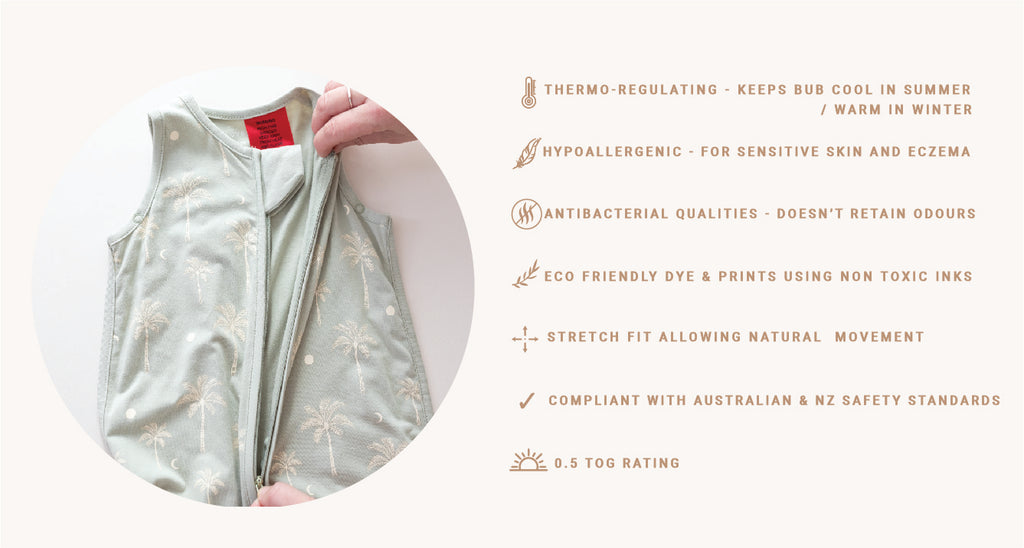Safe Sleeping habits

How to Sleep Your Baby Safely
Your baby's safety is our highest priority, which is why we recommend you use these five safety tips when putting your baby to bed:
- Sleep baby on the back from birth, not on the tummy or side
- Sleep baby with head and face uncovered
- Keep baby smoke free before birth and after
- Provide a safe sleeping environment night and day
- Recommended to sleep baby in their own safe sleeping place in the same room as an adult caregiver for the first six to twelve months
Choosing the right TOG Rating
Our Slumber Sacks are rate 0.5 Tog which means it is ideal for our warm weather and specifically room temperatures between 24-27° C. Bamboo is naturally thermo-regulating. This means it helps to keep baby cool when its hot and warm when it's cold. Then we blended with just the perfect amount of Organic cotton to make it buttery soft, breathable & comfortable.
A number of external factors determine the TOG rating of the sleeping bag that should be used.
These include the amount of clothes your baby is wearing, the temperature of the bedroom and even your baby's health. These factors may vary, so please only use our advice as a guide only.
- Monitor your child's temperature
- No additional bedding is to be used with this sleep bag
- Not to be used with a quilt or blanket

Why Choose Bam Loves Boo Slumber sacks
Research has shown that among the benefits of using a safe baby sleeping bag (a safe baby sleeping bag has fitted neck and armholes and no hood and is the correct size for baby) are:
- They reduce the risk of bedclothes covering baby’s face
- They delay baby rolling onto the tummy during sleep until baby’s past the age of peak risk of SUDI (sudden unexpected death in infancy)
- They promote back sleeping as the zipper opens to the front
- They will keep baby’s temperature at a more constant level while sleeping
Bam Loves Boo Sleeping bags follow all Australian and New Zealand Standards and comply with the AS/NZS 1249:2014 SAFETY STANDARDS ACT

Creating a Safe Place for your Baby to sleep
A safe sleeping environment means that all potential dangers have been removed and the baby is sleeping in a safe place. The ideal place for a baby to sleep is in a safe cot, on a safe mattress, with safe bedding in a safe sleeping place, both night and day.
Unsafe settings for baby’s sleep-time include leaving baby unattended on an adult bed or bunk bed, placing baby on a waterbed, beanbag, couch, pillow or cushion, or with a sleeping adult or child on a couch, sofa or chair.
Keep baby’s cot away from hanging cords such as blinds, curtains, or electrical appliances as they could get caught around baby’s neck. Keep heaters or any electrical appliances well away from the cot to avoid the risk of overheating, burns and electrocution. Never use electric blankets, hot water bottles or wheat bags for babies.
Co-Sleeping
Sharing a sleep surface with a baby can increase the risk of sudden unexpected death in infancy (sudi), including sudden infant death syndrome (sids) and fatal sleep accidents.
The safest place to sleep a baby is in their own safe sleeping place in the same room as an adult care-giver.
- Red Nose recommends sleeping a baby in a cot next to the parents’ bed for the first six to twelve months of life as this has been shown to lower the risk of SUDI.
- There is much debate in the literature about the practice of, and definitions for, bed-sharing and co-sleeping. For the purpose of this statement the term ‘sharing a sleep surface’ is used to include bed-sharing and co-sleeping practices. Bed-sharing refers to bringing the baby onto a sleep surface where co-sleeping is possible, whether intended or not. Co-sleeping is defined as a mother and/or her partner (or any other person) being asleep on the same sleep surface as the baby.
- Sharing a sleep surface with a baby can increase the risk of SUDI. A considerable proportion of SUDI occur on a shared sleeping surface.
- Babies most at risk of SUDI when sharing a sleep surface are those less than 3 months postnatal age4-5, babies who were born preterm or small for gestational age.
- The risks are always much greater if parents smoke or are under the influence of alcohol or drugs (prescription or illegal) that cause sedation and impair their ability to respond to their baby.
- There is a very high risk of infant death, including deaths attributed to fatal sleeping accidents, when a baby shares a sofa or couch with an adult during sleep.
- There is no increased risk of SUDI whilst sharing a sleep surface with a baby during feeding, cuddling and playing providing that the baby is returned to a cot or their own safe sleeping surface before the parent goes to sleep.
Sharing a sleep surface with a baby is a complex issue that encompasses many factors. Strategies can be used to reduce the risk in circumstances where parents share a sleep surface with a baby due to parenting preferences, cultural beliefs or unavoidable living circumstances, including instances where a parent may unintentionally fall asleep with a baby
To Wrap and not to Wrap
If you wrap your baby, consider baby’s stage of development. Leave arms free once the startle reflex disappears around 3 months. Most babies eventually resist being wrapped. Wrapping style should be appropriate for the baby’s developmental stage.
It is essential to discontinue wrapping as soon as baby starts showing signs that they can begin to roll, usually between 4-6 months of age but sometimes younger. Babies must not be wrapped if sharing a sleep surface with another person. Baby should not be wrapped while sleeping in a baby sleeping bag.
Our Information has been obtained from REDNOSE for more information on sleeping practices and advise please head to www.rednose.com.au
Bam Loves Boo Slumber sacks follow all Australian and New Zealand Standards and comply with the AS/NZS 1249:2014 SAFETY STANDARDS ACT

